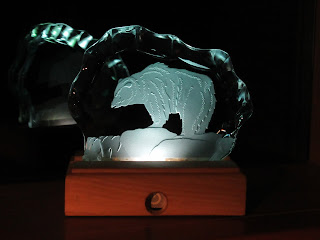This is a variation on a design that I first made about twenty years ago. Originally, I used this "fan" shape, and several other designs, to make kiln-fired glass panels for candle holders. I called that first design a "candle fan" because the shape reminded me of a hand held fan.
Here is one of the original pieces illuminated by a candle.
The candle flame gives a warm glow to the glass and a variable angle of illumination as the candle burns down. The hanging lead crystals give their own variation with daylight as they refract the full spectrum of sunlight into the prismatic spectrum of colours.
The multiple colour LEDs in these new pieces, however, allow a choice of changing colours (fast or slow, or a steady white, red, blue or green) to highlight the etched and fused glass.
While daylight can be used to enjoy the coloured glass, lead crystals and carved details, the LEDs highlight different aspects of display possibilities of these pieces.
Intricately carved details can be enjoyed upon closer examination.
These pieces can also be used as an accent light on a table or shelf.
The LEDs are powered either by rechargeable AAA batteries or directly plugged into a USB port or charger.
These pieces (and more!) are available through my Etsy shop : "CarvedglassArt".
See my new work on Instagram: "chuckstj"
Or email me for more info: nimbusglass@cablelan.net








































